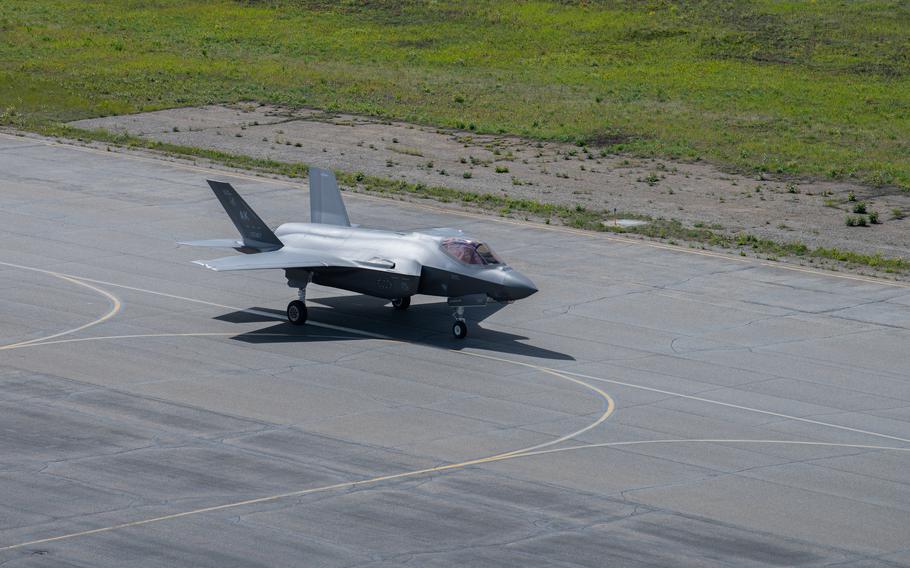
A U.S. Air Force F-35 Lightning II with the 356th Fighter Squadron taxis to the runway during Red Flag-Alaska 2023 at Eielson Air Force Base, Alaska, June 13, 2023. (Cedrique Oldaker/U.S. Air Force)
Outdated weapons lead to disasters, as Russia is demonstrating to the world. Seeking to gain the advantage, Ukraine begs for more-modern aircraft to defeat its invaders. In particular, they want the F-16 Fighting Falcon.
But as valuable as F-16’s would be to Ukraine, they are no longer cutting-edge.
The U.S. Air Force has been flying the F-16 since 1979, with about a thousand still in service, plus similar numbers flown by American allies. It’s a great fighter with proven value and durability, aided by numerous upgrades during its 44 years of use.
Yet America is replacing its F-16’s because they are “last-generation.” We’re transitioning into 5th-generation stealth fighters, in particular the F-22 Raptor and the F-35 Lightning II.
Advances and constant updating are key to America’s military superiority, in high contrast to the rapid obsolescence demonstrated by Russia. The U.S. complements the best weapons systems with the best-trained men and women of any military in the world.
This superiority is expensive, of course. Developing and deploying the F-35 is the Pentagon’s largest procurement program. Since going operational, the Lightning II has become the Air Force’s second-largest fleet, second only to the F-16, which the F-35 will gradually replace. (NATO and other U.S. allies are purchasing F-35’s in bulk to share the costs and benefits.)
As expensive as they are, each F-35 costs significantly less than an F-22. The Raptor is awesome at air superiority, but it cannot serve multiple roles with the Lightning’s versatility. Only the F-35 has three variants: the F-35A for fixed-base operations, the F-35C configured for Navy carriers, and the F-35B used by the Marine Corps to support assaults with its STOVL (Short Take-Off and Vertical Landing) capability.
Congress now has an important decision regarding the F-35, crucial because that aircraft is becoming the backbone of our fighter jets. At stake is the domination of the skies, which is the key to success for America’s military, coupled with highly-flexibility capabilities.
The problem, simply put, is that the F-35’s engines overheat. Although not restricting performance and mission capability, the overheating increases maintenance costs and limits the service life of each F-35. The core issue in Congress is whether to upgrade the existing Pratt & Whitney F135 engines to solve the overheating through a modernization program known as the Engine Core Upgrade (ECU), or to start developing a new engine with other contractors.
Upgrading the engines maintains all three F-35 versions. But the other approach (known as the Adaptive Engine Transition Program — AETP), instead would start a new multibillion-dollar program not focused on the F-35, but also intended to be used in other not-yet-designed future aircraft. It would, crucially, not work in the Navy or Marine Corps variants of the F-35.
The Pentagon has asked Congress for the upgrade but not the AETP. But the recently passed House version of the 2024 defense authorization bill would fund the AETP for $588 million in 2024. This threatens the F-35’s flexibility while taking funds away from other military needs. A May report by the Government Accountability Office confirms that only the upgrade option will be useful for all three variants of the F-35, buttressing the Pentagon decision to go with Engine Core Upgrade.
The upgrade also costs significantly less than the AETP’s new engine design. With limited budgets, upgrading is financially most prudent.
Tight budgets mean tough decisions for Congress. But the clear advantage both in cost and in maintaining the versatility of the F-35 is going with the engine upgrade, to extend the service life of our future mainstay fighter. That will mean America’s military can continue to dominate the skies.
Ernest Istook, a Republican, represented Oklahoma’s 5th congressional district in the House of Representatives from 1993-2007. He was on the House Appropriations subcommittee on national defense that approved funding for the Joint Strike Fighter that became the F-35.